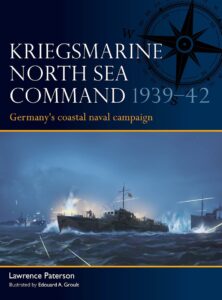Lawrence Paterson, Kriegsmarine North Sea Command 1939-42 (Osprey, 2025)
Readers of World War II will be well aware of the Battle of the Atlantic, with its U-boats and pocket battleships waging war against the Allies on the high seas. But Lawrence Paterson, in Kriegsmarine North Sea Command 1939-42, surveys the naval war off the European and British coastlines. Here the ships may have been smaller but the combat no less intense.
Paterson begins with the fleet’s purpose, which was primarily to protect its North Sea coastline and trade routes while carrying the war to enemy coasts. The North Sea also provided the jumping-off point for offensive operations in the Atlantic. All of that was set against Britain’s threat to blockade Germany. The Germans would do this, argues Paterson, through a form of nautical guerilla warfare, including attacks on shipping off the British coast and laying minefields. Paterson next surveys the classes of ships the Germans used to pursue their objectives: light cruisers, destroyers, torpedo boats and schnellboote, fleet escort ships, and minesweepers. He also covers the main weapons, such as torpedoes and mines, and here he includes cooperation with the Luftwaffe, though later we find out how ineffective that was.
With the ships and weapons all accounted for, Paterson considers the command organisation and sub-commands of this diverse fleet before taking a deeper dive into the complex roles of intelligence and logistics. Paterson closes with a narrative section on the fleet in combat, beginning in 1939 with destroyer led minelaying operations off the British coast sometimes leading to combat with Royal Navy forces. The action continued into 1940, with more minelaying and a disastrous friendly-fire incident leading to a drop in morale amongst the destroyer crews. That year also saw the invasion of Norway, involving much of the North Sea fleet, though they could do little to prevent the evacuation of Dunkirk in May. Here, Paterson brings the S-boats to the fore, highlighting their hit-and-run attacks on Allied shipping. The following two years saw a greater RAF presence, though mining and attacks continued, the tide was turning against the Germans. Paterson concludes that what had started out as a promising campaign ran into the same problems that doomed the Third Reich military campaigns elsewhere: the fleet was understrength, there was no clear strategy, and inter-service rivalry blighted operations.
I must confess, I did not have high hopes for this book about what felt like a secondary front in the naval war, but I was pleasantly surprised. Paterson’s narrative of the small-scale actions is well written and brings out the often knife-edge nature of this form of combat. His analysis also provides useful insight into how a promising early war situation for the Germans steadily turned into morale sapping defeat. As usual with Osprey, the author is well supported by high quality graphic illustrations, maps, and photographs of the various ships. This is a book full of incident, and naval warfare readers should enjoy it.
